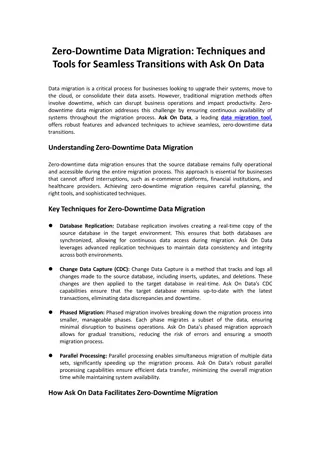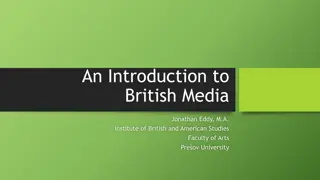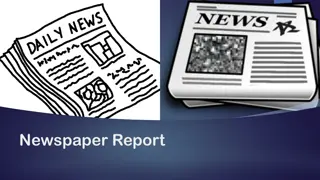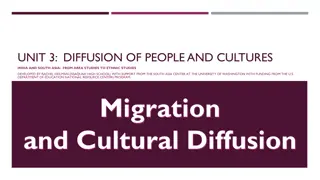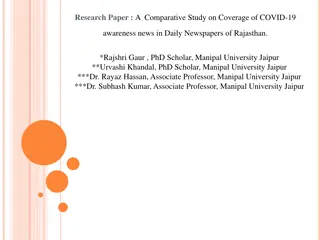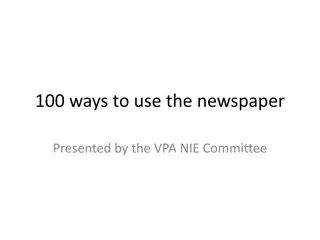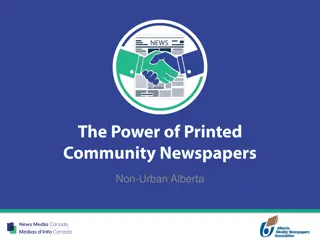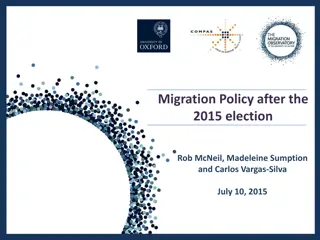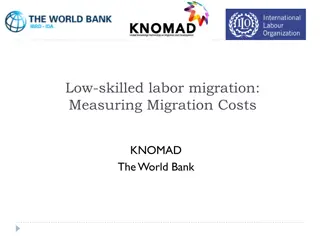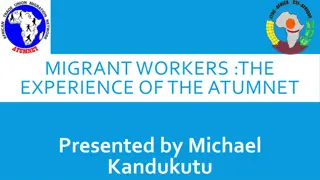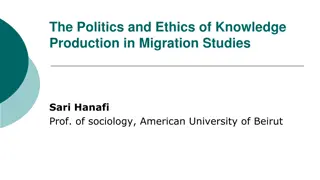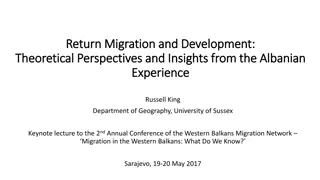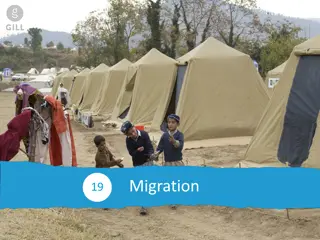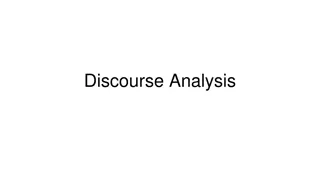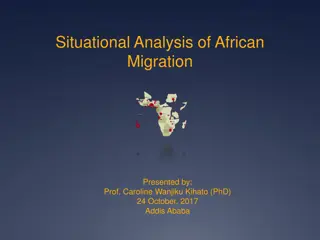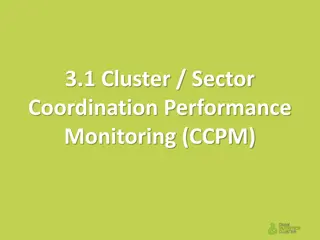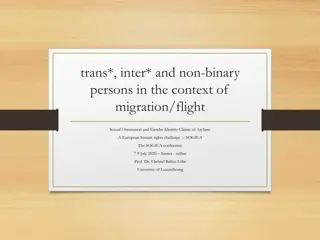Gender and Migration Discourse in British Newspapers Study
Analyzing the discourse surrounding gender and migration in British newspapers, this study delves into the portrayal of migrants as the "Other" in media coverage. Focusing on UK national newspapers, the research examines spikes in media attention post-Brexit referendum and explores the intersection of gender, migration, and media representation.
Download Presentation

Please find below an Image/Link to download the presentation.
The content on the website is provided AS IS for your information and personal use only. It may not be sold, licensed, or shared on other websites without obtaining consent from the author. Download presentation by click this link. If you encounter any issues during the download, it is possible that the publisher has removed the file from their server.
E N D
Presentation Transcript
Gender and migration discourse in British newspapers Alexandra Polyzou alexandra.polyzou@canterbury.ac.uk & Amina Kebabi a.kebabi417@canterbury.ac.uk
Outline 2 Background and details of the study Literature and findings Discussion and concluding remarks
CDS, migration discourse and Othering 3 Discourse(s) on migration well studied in CDS (e.g. Wodak, 2011; KhosraviNik, 2014, Charteris-Black, 2016; Demetriou, 2018; Drywood & Gray, 2019) Key socio-cognitive Us/Them distinction, construction and legitimation of exclusionary identities and practices (van Dijk, 1993) Cognitive framing in discourse triggering and further reinforcing defensiveness and fear (Hart, 2010; 2011; Musolff, 2015) Range of fields (e.g. mass or social media, politics) and contexts (historical, national, institutional)
Gender, migration, media 4 Migration is a gendered process and so are the media (Liu, 2021: 2). Intersectionality vs. add women and stir (Hondagneu-Sotelo & Cranford, 2006) Growing body of work on analysis of gender and migration in media discourse
This study 5 UK newspapers 6 national newspapers Lexis/Nexis* Tabloids: The Sun, The Mirror & The Daily Mail. Broadsheets: The Guardian/Observer, The Independent & The Times. Texts related to migration but not gender as such No distinction as to (sub)genre
Data 6 expected spikes (KhosraviNik, Wodak & Krzy anowski 2012; KhosraviNik 2014) in media coverage of immigration in the UK. 2 weeks after Brexit referendum announcement 22 Feb - 7 March 2016 (coincides with continuing refugee crisis) 2 weeks after Brexit referendum 23 June 7 July 2016 Same 2-week periods 4 years later 22 Feb 2020 7 March 2020 23 June 2020 7 July 2020 Total: 4 periods x 6 newspapers = 24 sets of data Set 1: The Sun, 22 Feb - 7 March 2016 (29 items)
7 Search term: *migra* migrant vs. immigrant, refugee, asylum seeker, expat, migr Manually excluded irrelevant texts (e.g. migraine ) Manually selected texts with reference to gendered individuals (two researchers) Starting with a focus on the representation of migrants themselves (the Others & the other Others)
The (im)migrant stereotype/ prototype 8 Young, male, able-bodied (e.g. Goodman, 2016; Demetriou & Polyzou, 2018) Aggressive (outside aggressor) Not needing or deserving compassion, help or acceptance Fear (Hart, 2010; 2011; Musolff, 2015) Blumell & Cooper, 2019: 4457; Liu, 2021
Male migrant as aggressor 9 Mostly activated actors of violent material processes. Consistent referential and predicational strategies. Germany imported more than a million Muslim migrants last year, mostly young men. (S-28-02-2016a) An Iraqi migrant raped a young boy in a swimming pool in Austria. His excuse was that he hadn't had much sex recently. (S-25- 02-2016a) An illegal migrant who entered the UK on the back of a lorry was caught a month later with 240,000 of cocaine. Helied (S-02- 03-2016a) The knifeman was disarmed after thrusting his blade at another man, who escaped unhurt. (S-03-03-2016c) A migrant molested a 15-year-old girl at a train station and claimed it was a misunderstanding caused by cultural differences. Ali Abdullahi, 34, also attacked a woman on his train home to Bristol. (S-07-03-2016b)
Male migrant as victim/ suffering 10 Humanising and/ or pity-evoking predications A weeping Afghan man carrying a child pushes against a fence on the Greek border (S-23-02-2016b) two young migrants trying to hang themselves in a crowded Athens square in broad daylight. The wretched men probably believed death was the only way they would ever get out. (S-27-02-2016a) Salesman Basil, 32, from Syria's ravaged capital Damascus, revealed: "It was freezing last night and our tent was swimming with water. I queued for hours for food but when I finally got near the front they ran out of supplies. (S-27-02-2016a) The knifeman was disarmed after thrusting his blade at another man, who escaped unhurt. (S-03-03-2016c) Back at the tense choke-point of Idomeni, I met Hussien Humduon huddled around a wood fire in the gathering evening chill. (S-27-02-2016a) I meet English literature graduate Khalil Naffissa at a filling station near Polykastro . Frantic teacher Khalil, 37, who is desperate to join his dentist wife and three daughters in Germany, (S-27-02-2016a)
The immigrant woman 11 Not identified frequently enough (in proportion to their numbers - Blumell & Cooper, 2019: 4456) Accessory to and reinforcing the stereotypical representation of the male immigrant ( how they treat their women ) Or you can have a society that lets in millions of men from male-dominated, womanhating cultures. (S-06-03- 2016) Utilised for evoking pity in refugee representations (cf. del Zotto, 2022 the passive refugee but cf. Blumell & Cooper (2019: 4457) Ambivalent representations in cases of human trafficking (Mattoscio & MacDonald, 2018) Strategically exacerbating Othering through women s physicality (Demetriou & Polyzou, 2018 cf. also Al Hejin, 2015) Blumell & Cooper (2019: esp. 4456-4457); Liu, 2021
Female migrant as mother and wife 12 Relational identification and association War-haunted Basil and Abir Trabulsi gaze forlornly at the razor-wire gateway that leads to prosperous northern Europe. Cradling eight-month-old son Fahed, Basil's Lebanese wife Abir (S-27-02-2016a) Census statistics show foreignborn mothers have more children than Brits. The Government insisted it had created 3,000 extra school places a month since September. (S-29-02- 2016a and b) Aylan, brother Galip, five, and mum Rehan were among those killed when their boat capsized near Bodrum as they fled from Kobani in Syria. (S-05-03-2016c) Local dad-of-two Apostole Giapoutzis, 51, told me: "Many the migrants I've seen are peaceful women and children (S-27- 02-2016a)
Unexpected representations? Women as agents 13 Frantic teacher Khalil, 37, is desperate to join his dentist wifeand three daughters in Germany (S- 27-02-2016a) A migrant threatened to cut her wrists during demolition of the Jungle camp yesterday. The Iraqi Kurd, believed to be pregnant, climbed on top of a makeshift hut and warned she would kill herself if bulldozers approached. (S-02-03-2016b)
Erasure 14 Erasure/ backgrounding of women? (Tuchman, 1979) Male as default ? Erasure of non-(hetero)normative gender identities Erasure of humanity Conventional link of sex/gender identity to humanity and respect Dehumanisation of migrants - Impersonalisation through aggregation, collectivisation, abstraction and objectification (van Leeuwen, 1996) the ambivalence of the refugee as either a sufferer or a threat, yet never a human (Chouliaraki & Stolic, 2017: 1165) In Chouliaraki & Zaborowski sdata refugees were predominantly described as groups in terms of their category membership: predominantly nationality (62% of all articles) and less so gender (24%) and age (27%). More personalized specifications, such as names and professions had the lowest frequency with 16% and 7%, respectively (2017: 623).
Dehumanisation of migrants and gender erasure (?) 15 Impersonalisation through: Aggregation: thousands more refugees will come (S-27-02-2016a) more than 8,000 migrants were left stranded last night after Macedonia refused to allow them entry . (S-23-02-2016b) 3,000 migrants have been offered heated accommodation (S-02-03-2016b) Collectivisation: send migrants across the Channel (S-03-03-2016b) (+objectification) blocking the paths of migrants attempting to cross from Greece to Macedonia (S- 05-03-2016b) lack of grammatical gender in English Nominalisations/abstraction (+objectification): arrivals from Europe may also outstrip those from the rest of the world for the first time. (S-25-02-2016b) migrant mobs suspected of hundreds of sex attacks in Cologne (S-25-02-2016b) cheap East European labour (S-04-03-2016) the migrant problems are still there (S-04-03-2016) migrant crisis (S-07-03-2016a)
Discussion/ concluding remarks 16 A combination of empathy with suspicion is an established pattern in the representation of human mobility (Chouliaraki & Stolic, 2017: 1163) Dehumanisation De-genederisation? the media implicitly masculinize immigration when framing it as an economic issue and implicitly feminize migration when framing it as a cultural issue (Liu, 2021: 2) heteronormative expectations projected onto migrants by national states and border officials, as well as by pro-immigration campaigns themselves (Mattoscio & MacDonald, 2018: 1118) and by mainstream media (and social media Goodman, 2007). Pattern so far: Distance empathy, Proximity suspicion/fear. Also Othering of Other host countries (Greece, Germany) Less other host countries (Austria, Germany, France) Calais as ambivalent cautionary tale Analyses of representations of other types of women migrants & closer look at representational conflation, as well as lived experiences (cf. Hondagneu-Sotelo & Cranford, 2006)
Questions? Comments? Feedback? Suggestions? Alexandra Polyzou alexandra.polyzou@canterbury.ac.uk & Amina Kebabi a.kebabi417@canterbury.ac.uk 17
References 18 Al-Hejin, B. 2015. Covering Muslim women: Semantic macrostructures in BBC News. Discourse & Communication, 9(1): 19 46 Blumell, L. & Cooper, G. 2019. Measuring gender in news representations of refugees and asylum seekers. International Journal of Communication, 13: 4444-4464. Charteris-Black, J. 2006. Britain as a container: Immigration metaphors in the 2005 election campaign. Discourse & Society, 17(5): 563 581. Chouliaraki, L. & Stolic, T. 2017. Rethinking humanity and responsibility in the refugee crisis : A visual typology of news media. Media, Culture & Society, 39(8): 1162-1177. Chouliaraki, L. & Zaborowski, R. 2017. Voice and community in the 2015 refugee crisis: A content analysis of news coverage in eight European countries. The International Communication Gazette, 79(6 7): 613 635.
19 del Zotto, A. 2002. Weeping Women, Wringing Hands: How the Mainstream Media Stereotyped Women's Experiences in Kosovo, Journal of Gender Studies, 11(2): 141-150. Demetriou, D. 2018. Discourse on immigration in the UK: representations and evaluations of Romanians and Bulgarians as benefittourists . PhD. thesis, Canterbury Christ Church University. Demetriou, D. & Polyzou, A. 2018. Representations of Gender and Ethnicity in the EU migration debate: An examination of UK (online) right-wing press. Critical Approaches to Discourse Analysis across Disciplines (CADAAD). 4-6 July 2018. Aalborg University, Aalborg, Denmark. Drywood, E. & Gray, H. 2019. Demonising immigrants: How a human rights narrative has contributed to negative portrayals of immigrants in the UK media, in Farrell, M., Drywood, E., and Hughes, E. (eds) Human Rights in the Media: Fear and Fetish. London: Routledge, 777-808.
20 Goodman, S. 2007. Constructing Asylum Seeking Families. Critical Approaches to Discourse Analysis Across Disciplines, 1 (1): 36-50. Goodman, S. 2016. The representation of refugees and the refugee crisis. Presentation, 16/11/2016, Canterbury Christ Church University. Hart, C. 2010. Critical Discourse Analysis and Cognitive Science: New Perspectives on Immigration Discourse. Basingstoke: Palgrave Macmillan. Hart, C. 2011. Force-interactive patterns in immigration discourse: A Cognitive Linguistic approach to CDA. Discourse & Society, 22 (3): 269-286. Hondagneu-Sotelo, P. & Cranford, C., 2006. Gender and migration. In Saltzman Chafetz, J. (ed.) Handbook of the Sociology of Gender. Boston, MA: Springer, 105-126. KhosraviNik, M. 2014. Immigration discourses and critical discourse analysis: dynamics of world events and immigration representations in the British press, in Hart, C. and Cap, P. (eds) Contemporary Critical Discourse Studies. London: Bloomsbury, 503 522.
21 KhosraviNik M., Krzy anowski, M. & Wodak, R. 2012. Dynamics of representation in discourse: Immigrants in the British press, in Messer M., Schroeder, R. & Wodak, R. (eds) Migrations: Interdisciplinary Perspectives. New York: Springer, 283 296. Liu, S. 2021. Gendering immigration: media framings of the economic and cultural consequences of immigration, Feminist Media Studies, 1-18. Mattoscio, M. & MacDonald, M. 2018. Introduction: Gender, Migration, and the Media. Feminist Media Studies. 18(6): 1117 1132. Musolff, A. 2015. Dehumanizing metaphors in UK immigrant debates in press and online media. Journal of Language Aggression and Conflict, 3(1): 41 56. Tuchman, G. 1979. Women's Depiction by the Mass Media. Signs, 4(3): 528-542. van Dijk, T. 1993. Principles of Critical Discourse Analysis. Discourse & Society, 4(2): 249-283. Wodak, R. 2011. Us and them : inclusion and exclusion discrimination via discourse. in G. Delanty, R. Wodak & P. Jones (eds), Identity, Belonging and Migration. Liverpool: University of Liverpool Press, pp. 54-77.


